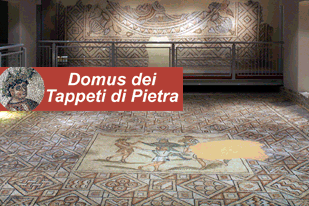The mosaic flooring in San Giovanni Evangelista



















The mosaic flooring in San Giovanni Evangelista. Hotels near the mosaic flooring of san Giovanni Evangelista in Ravenna.
Photo: see the text
Summary of "A NEW READING" by Nurith Kenaan-Kedar.
I would like to assert that the flooring was offered as ex-votum by an unhurt donor coming back home, in Ravenna, after having fought in the IV Crusade ( probably similarly to other XIII and XIV century floorings in Lombardia and Piemonte).
It was not a coincidence the fact that the donor chose the church of San Giovanni Evangelista for the mosaics. As it is known, the church was erected in Ravenna by the Empress Galla Placidia as ex-votum after her journey to Costantinople to obtain the government of the Western Roman Empire in place of her son ValentinianoIII.
We have many documents proving that between the V and XVI century the portraits of all the members of Theodosio's family were represented in the apse, as well as a scene depicting San Giovanni Evangelista while saving Theodosio's daughter Galla Placidia and her sons from a seastorm. This mosaic in memory of Galla Placidia faced the believers and it was probably the inspiration for the anonymous donation of the mosaic flooring, a noteworthy and common artistic gesture in Ravenna at that time.
The mosaic cycle represents the complete memory of a particular journey and not only a whole of single themes. My reconstruction of this cycle is the following one:
lower frame.
•The story starts with a Bishop sitting in the Episcopal seat ( he is identified by his mitre) while a nobleman, dressed in a short tunic and cloak, is giving him or receiving from him a written message - to be read as a charge for a mission.(1)
•The knight - or nobleman - farewell scene to his wife. The man on the left is saying goodbye to a woman holding a flower, symbol of true love. (2)
•There are surely two fragments depicting sailing ships. In the first fragment there is the man a horn. (3/4)
•The first register includes, in my opinion, soldiers starting the war, and another panel depicting two fighting soldiers.(5/6)
•the battle of Zara and the battle of Constantinople. They both describe the moment of prisoners' killed by Crusaders.(7/8)
• the journey homeward bound-the patron vessel is standing up on the mainmast looking at the sea. This description can be connected to the fragment of the ship. (9)
•The woman is giving the man a flower. This time she is on the left side of the panel and he is on the right side. The story has to be read starting from the woman's side. (10)
This is the story of a Medieval Odyssey. The man, who left for a Crusade, came back home unhurt. The whole story is accompanied, in parallel, from two registers of animals and flowers that symbolize vices and values of human nature
I attempted to undergo the reconstruction of the registers placing the animals symbols of virtues above the cycle, and the animals symbols of vices, below it.
Animals and plants symbolizing the virtues are an ox, a deer, two fish, a flower, a unicorn, a dove and another flower.
As noticed, they are each the symbols of Faith, Hope, Charity and Purity. Creatures and animals below , symbols of vices, are: a tiger, a griffin, a harpy, a mermaid and a fox. These animals symbolize the Devil in his multiple aspects, as seduction, rage and vanity. Other two fables describe vices: the Fable of the Fox and the Fable of the Goose.(11/12/13/14/15/16/17/18)
All these animals and legendary creatures are already present in the Physiologus, but they also have been cited in sermons, hymns and other XII and XIII century works with the same style.
In support of this proposed scheme, I put the monogram of the monk on duty when the mosaic was realized above the figure of the woman with a twig in her hand - the twig has always been the symbol of faith and eternal life. In this way she seems to give the monk the mosaic in honour of her husband. (19)
This hypothesis is supported by the date on the mosaic -1213. If the knight was back in 1204-1205, then why was the mosaic made in 1213. It is more possible that the pavement was made by the wife in his memory only after his death.
The image of the uprooted tree, consequently, can represent this event.
The reconstruction of the mosaic as a commemorative story, with its two registers of animals symbols of vices and virtues, recalls both the structure of the tapestry of Bayeux, in which the main story is framed by images of animals and fables, and other XIII century mosaic floorings.
The mosaic style is linear.
This artistic language assumes that this cycle is a personal memory, maybe an ex-votum given to the Abate Guglielmo by the protagonist donor or by his wife, after his death in 1213.
Prof. Nurith Kenaan-Kedar
The pleasure of fine accommodation in the centre of Ravenna: we recommend the Fabbri hotels for a pleasant stay as follows:
The Centrale Byron Hotel, 3-star hotel in the centre of Ravenna, close to the main momuments;
The Bisanzio Hotel, 4-star hotel in the centre of Ravenna, close to the main momuments;
Once you have reached the hotel and parked your car, forget it and walk everywhere, because everything is within walking distance.
The railway station is near our hotels and within walking distance
©reserved reproduction





